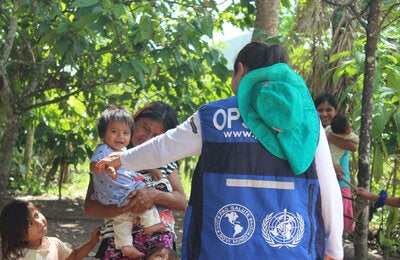
More people were at risk for this disease in Guatemala than in any other country in the Americas. PAHO, OEPA and other partners contributed to the elimination effort.
Washington, D.C., 26 September 2016 (PAHO/WHO)-Following efforts that spanned more than two decades, Guatemala has become the fourth country in the Americas and the world to be declared free of onchocerciasis (river blindness), a disease that can cause blindness and disability and that primarily affects people living in poverty.
The announcement was made today by Dr. Carissa F. Etienne, Director of the Pan American Health Organization (PAHO), at the opening session of the 55th PAHO Directing Council in Washington, D.C.
"PAHO congratulates Guatemala on this important achievement for regional and global public health," said Etienne.
Guatemala joins Colombia, Ecuador and Mexico, which achieved elimination between 2013 and 2015, following the commitment made by affected PAHO member countries in 1991 to interrupt transmission of onchocerciasis. The final step toward making the entire Region of the Americas free of the disease is to eliminate it from Amazonian indigenous communities living along the Brazil-Venezuela border.
Onchocerciasis is a parasitic disease caused by a long, thin worm known as filaria. The disease is transmitted by the bite of infected black flies commonly known in Guatemala as "canche" flies, which breed in fast-flowing rivers and streams, especially in areas where the population is dependent on agriculture. Because of the environment in which the flies breed, the disease is also known as "river blindness."
Guatemala's achievement
Of the six countries in the Americas where transmission was present in the 1990s, Guatemala had the greatest number (four) of foci of transmission and the greatest number of people at risk for onchocerciasis, accounting for about 41% of the 568,000 people at risk in the Americas.
"Elimination has been made possible by our country's strong commitment, the efforts of our health workers and volunteers, and the high level of participation and empowerment of affected communities," said Minister of Health of Guatemala Lucrecia Hernández Mack. "Health is a priority for all. So we will continue to work to eliminate other neglected infectious diseases affecting our most vulnerable population."
Guatemala's main strategy to achieve elimination involved periodic mass administration of the antiparasitic drug Mectizán® (ivermectin), delivered twice a year for up to 12 years and calibrated to the weight and height of individual recipients. The country succeeded in covering at least 85% of the eligible population each time the treatment was offered.
Support for these and other country efforts was provided by PAHO/WHO, the Carter Center's Onchocerciasis Elimination Program for the Americas (OEPA), and Merck's Mectizan® Donation Program in the form of technical assistance, funding, and drugs for national programs to eliminate the disease.
A Guatemalan physician and researcher, Dr. Rodolfo Robles, also played an important role in combating this disease. In 1915, Robles determined the causal relationship between this parasitic infection and the blindness and other visual alterations it causes, after this had been described in Africa. In his honor, onchocerciasis is known in Guatemala as "Robles disease."



